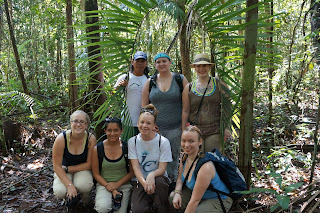Our
early morning began at five o’clock in the morning for a sunrise contemplation.
We took the motor boat out to the middle of a lake within the Rio Negro and we
waited and watched as the sun came up from behind the trees. It was a beautiful sight. The Amazon came
alive as the birds chirped above us. The natives have recognized that certain birds
chirp at specific times, therefore, Leandro knew that it was 6 o’clock when the
toucan began to sing.
Our next activity was a three and a
half hour jungle hike through the rainforest. Due to the high water level of
the river, parts of the trail were flooded, which forced us to find a new
starting point. When we reached the main trail, it was noticeably narrow. It
was just enough for one person to walk on. This lessens the amount of damage to
the plant life in the Amazon. The hike was very adventurous and included caves,
rivers, fallen trees, and bats.
On our way back to the lodge, we
made two stops. We first visited a watch tower that had an amazing view of the
river and rainforest and was a great photo opportunity. After eating lunch and
taking a short swim, we headed to our next stop. It was a dolphin
rehabilitation center in a village called Novo Airao where Leandro lives. One
woman took the risk to care for wild dolphins that had been injured by local
fisherman that once considered them pests. For sixteen years she has been
feeding and caring for the pink dolphins, but also allows them to come and go
freely. The dolphins are able to survive with her help, yet they still have the
ability to live in the wild. As a group, we were able to have close interaction
with the dolphins. We sat low to the water as the owner fed them. As they came
up out of the water to eat, we were able to pet their soft bellies. The type of
interaction that visitors are allowed to have with the dolphins has changed
over the years. In years past, people swam with and fed numerous amounts of
fish to the dolphins. The people of the village have learned about ecotourism through
the Anavilhanas National Park protection. They now know that this cannot continue. To keep the
dolphins and people safe, tourists’ interaction is now limited. However, we
were very lucky to have the opportunity to have contact with the pink dolphins.
It was an amazing experience! Tonight,
we will be getting a good night’s sleep after a fun and exhausting day. Tomorrow
we will be leaving the ecolodge and staying at a Non-Government Organization
where we will have several volunteer opportunities.
Hiking through the Amazon








